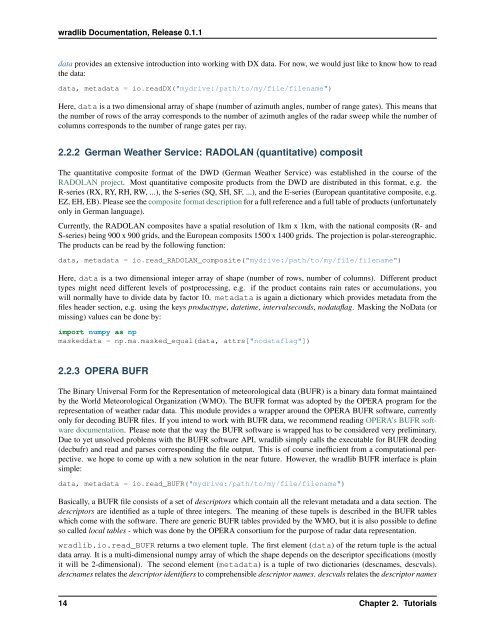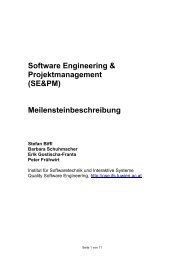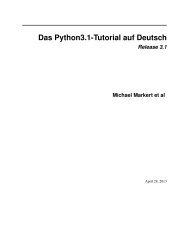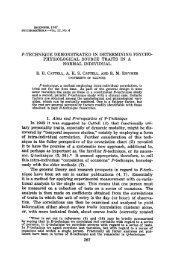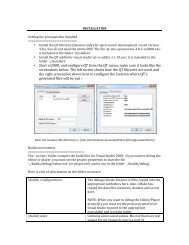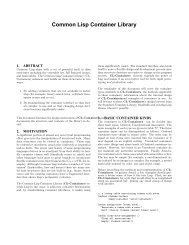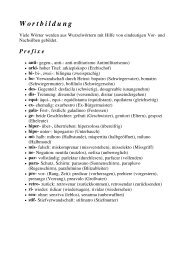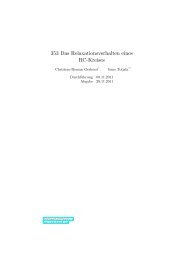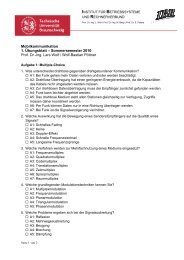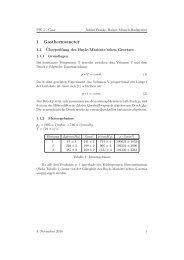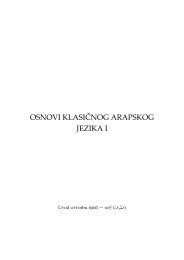wradlib Documentation - Bitbucket
wradlib Documentation - Bitbucket
wradlib Documentation - Bitbucket
Create successful ePaper yourself
Turn your PDF publications into a flip-book with our unique Google optimized e-Paper software.
<strong>wradlib</strong> <strong>Documentation</strong>, Release 0.1.1<br />
data provides an extensive introduction into working with DX data. For now, we would just like to know how to read<br />
the data:<br />
data, metadata = io.readDX("mydrive:/path/to/my/file/filename")<br />
Here, data is a two dimensional array of shape (number of azimuth angles, number of range gates). This means that<br />
the number of rows of the array corresponds to the number of azimuth angles of the radar sweep while the number of<br />
columns corresponds to the number of range gates per ray.<br />
2.2.2 German Weather Service: RADOLAN (quantitative) composit<br />
The quantitative composite format of the DWD (German Weather Service) was established in the course of the<br />
RADOLAN project. Most quantitative composite products from the DWD are distributed in this format, e.g. the<br />
R-series (RX, RY, RH, RW, ...), the S-series (SQ, SH, SF, ...), and the E-series (European quantitative composite, e.g.<br />
EZ, EH, EB). Please see the composite format description for a full reference and a full table of products (unfortunately<br />
only in German language).<br />
Currently, the RADOLAN composites have a spatial resolution of 1km x 1km, with the national composits (R- and<br />
S-series) being 900 x 900 grids, and the European composits 1500 x 1400 grids. The projection is polar-stereographic.<br />
The products can be read by the following function:<br />
data, metadata = io.read_RADOLAN_composite("mydrive:/path/to/my/file/filename")<br />
Here, data is a two dimensional integer array of shape (number of rows, number of columns). Different product<br />
types might need different levels of postprocessing, e.g. if the product contains rain rates or accumulations, you<br />
will normally have to divide data by factor 10. metadata is again a dictionary which provides metadata from the<br />
files header section, e.g. using the keys producttype, datetime, intervalseconds, nodataflag. Masking the NoData (or<br />
missing) values can be done by:<br />
import numpy as np<br />
maskeddata = np.ma.masked_equal(data, attrs["nodataflag"])<br />
2.2.3 OPERA BUFR<br />
The Binary Universal Form for the Representation of meteorological data (BUFR) is a binary data format maintained<br />
by the World Meteorological Organization (WMO). The BUFR format was adopted by the OPERA program for the<br />
representation of weather radar data. This module provides a wrapper around the OPERA BUFR software, currently<br />
only for decoding BUFR files. If you intend to work with BUFR data, we recommend reading OPERA’s BUFR software<br />
documentation. Please note that the way the BUFR software is wrapped has to be considered very preliminary.<br />
Due to yet unsolved problems with the BUFR software API, <strong>wradlib</strong> simply calls the executable for BUFR deoding<br />
(decbufr) and read and parses corresponding the file output. This is of course inefficient from a computational perpective.<br />
we hope to come up with a new solution in the near future. However, the <strong>wradlib</strong> BUFR interface is plain<br />
simple:<br />
data, metadata = io.read_BUFR("mydrive:/path/to/my/file/filename")<br />
Basically, a BUFR file consists of a set of descriptors which contain all the relevant metadata and a data section. The<br />
descriptors are identified as a tuple of three integers. The meaning of these tupels is described in the BUFR tables<br />
which come with the software. There are generic BUFR tables provided by the WMO, but it is also possible to define<br />
so called local tables - which was done by the OPERA consortium for the purpose of radar data representation.<br />
<strong>wradlib</strong>.io.read_BUFR returns a two element tuple. The first element (data) of the return tuple is the actual<br />
data array. It is a multi-dimensional numpy array of which the shape depends on the descriptor specifications (mostly<br />
it will be 2-dimensional). The second element (metadata) is a tuple of two dictionaries (descnames, descvals).<br />
descnames relates the descriptor identifiers to comprehensible descriptor names. descvals relates the descriptor names<br />
14 Chapter 2. Tutorials


